Helene Pessl
Helene Pessl was born Helene Herz in Vienna, Austria, the daughter of the Jewish owner of the Café Marienbrücke, Ignaz Herz and his wife Charlotte Herz, née Winternitz. In 1905, she married Sigmund Pessl, a famous Viennese hairdresser and parfumier and the couple had two children in quick succession – Yella (1906) and Margot (1907). It was through this marriage that she got into the beauty business.
Sigmund Pessl
Sigmund Pessl (Pessel) was born in Devin (German: Theben), now a suburb of Bratislava, Slovakia but went to school in Stockerau. Like Helene he was a Jew. In 1883, he made his way to Vienna where he secured an apprenticeship with the hairdresser Josef Holzborn in his salon at Mariahilferstrasse 5. As a journeyman, Sigmund went first to Berlin and then, via Paris, to London where he worked for many years. In 1894, he returned to Vienna and took over a salon at Josefstädterstrasse 16 where he introduced Marcelling – a hair-waving technique generally credited to Marcel Grateau [1852-1936] of France – to Viennese society ladies with great success. In 1898, he moved his salon to Kärntnerstrasse 28 by which time he was one Vienna’s best-known hairdressers with clients that included European royalty.

Above: Sigmund Pessl business card displaying an assortment of royal crests of clients.
By 1920, Pessl had opened a second salon in Budapest at Váci utca 19 and now provided clients with a range of beauty treatments. Operation of the Budapest salon appears to have been controlled by Helene Pessl.
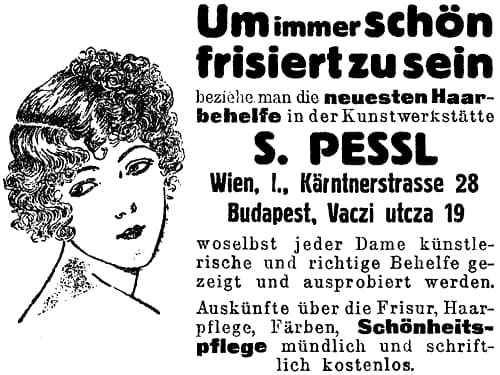
Above: 1920 S. Pessl salons in Vienna and Budapest.
In April 1, 1922, Pessl took over the women’s hairdressing and beauty salon in the Dianabad health resort in Vienna. By now, Pessl salons offered a wide range of beauty treatments including manicures, pedicures, massage treatments and facials, many delivered by Illy Girschner.
Factory
In 1923, Pessel established a factory (parfumeriefabrik) at Josefstädterstrasse 29 which produced perfumes, powders, creams and a range of specialty products for sale through their salons and other outlets.
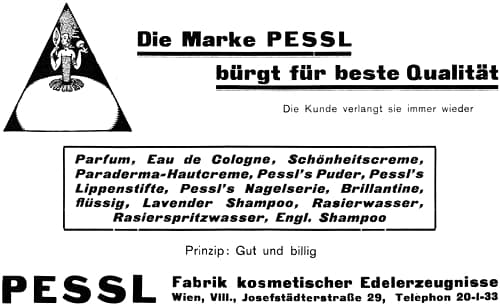
Above: 1925 Pessl fabrik kosmetischer.

Above: 1925 Laboratory at the parfumeriefabrik Pessl.
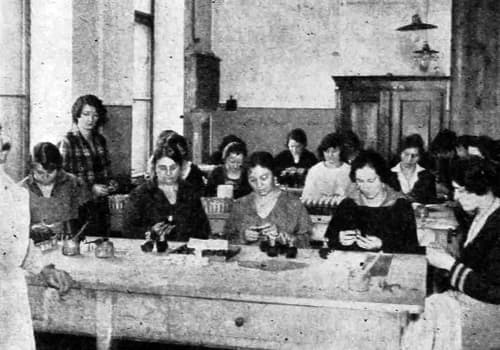
Above: 1925 Filling and packing room at the parfumeriefabrik Pessl.
Separation
In 1925, Sigmund and Helene divorced for reasons unknown to me and the business assets were separated. Although Helene was in charge of the Pessl salon in Budapest, Sigmund kept it and Kärntnerstrasse salons while the Dianabad salon and the Pessl factory at Josefstädterstrasse 29 went to Helene (Breuss, 2020). Illy Girschner stayed with Sigmund and continued providing beauty services at the Kärntnerstrasse salon through to 1934.
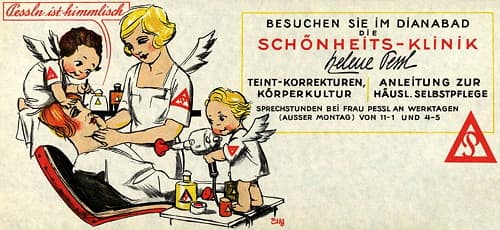
Above: 1928 Helene Pessl Dianabad.
After a rocky start – in which the factory equipment was temporarily impounded due to unpaid taxes – Helene Pessl’s business thrived and she became one of the best known beauticians in Vienna. In addition to managing the Dianabad salon and the factory, she wrote numerous articles for Viennese newspapers and magazines and founded a beauty school – the Schönheitspflege-Institut von Helene Pessl – which conducted short and long-term training courses.
Beauty School
Helene Pessl’s beauty school emerged from a trip she made to Paris in February, 1927. There she visited a new beauty school established by the French Ministry of Technical Education which had opened in January.
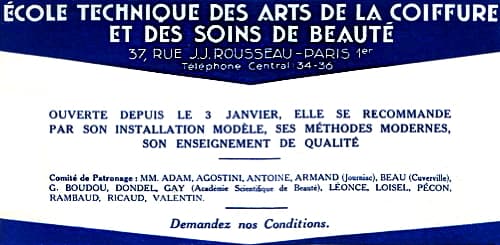
Above: 1927 École Technique des Arts de la Coiffure et des Soins de Beauté, Paris.
By August, 1927, Pessl had used what she had learnt in Paris to established her own beauty school which ran classes in Dianabad and Marienbrücke.
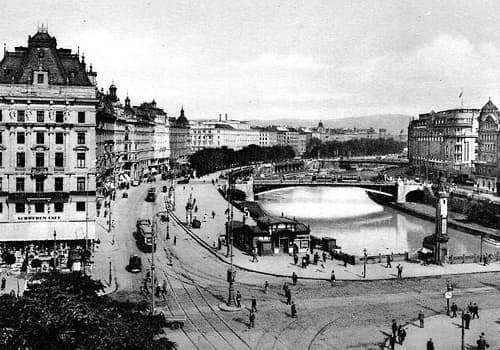
Above: 1929 Marienbrücke bridge (center with tram running across it) and Dianabad (right).
The initial training program ran for two months but shorter night courses were added later.

Above: 1928 Helene Pessl Schönheitspflege-Insitut.

Above: 1937 Facial demonstration in the Schönheitspflege-Insitut.
Following their training, students could do an internship in the Dianabad salon.
Salon treatments
The Helene Pessl salon – refurbished in 1933 by the architect Walter Sobotka [1888-1972] – provided clients with a complete range of beauty services using local and imported machinery and techniques. She was, for example, in favour of both steaming and oxygen treatments and used both French Pulverisers and Viennese Oxylators in her salon.
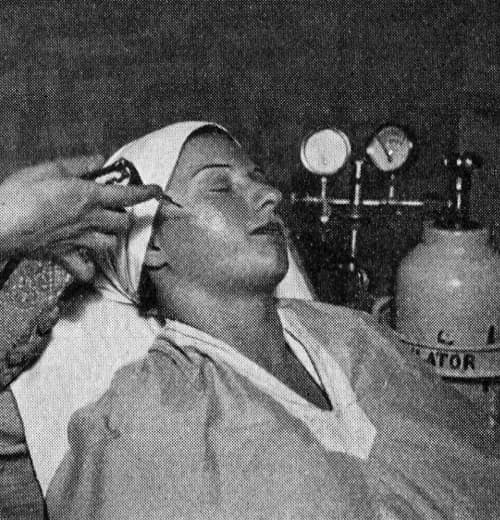
Above: 1935 Oxylation treatment.
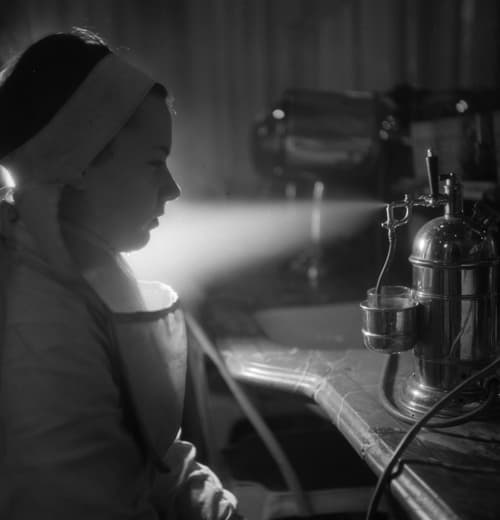
Above: 1937 Pulveriser treatment (Wien Museum).
See also: Skin Breathing and Vaporisers
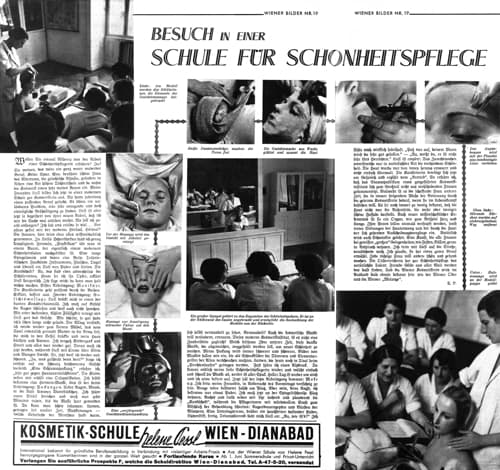
Above: 1936 Article on the refurbished Pessl Kosmetik-Schule.
Massage
Like other major salons in the inter-war period, electrical machinery featured heavily in treatments but manual massage was still considered to be the most important part of any beauty program.
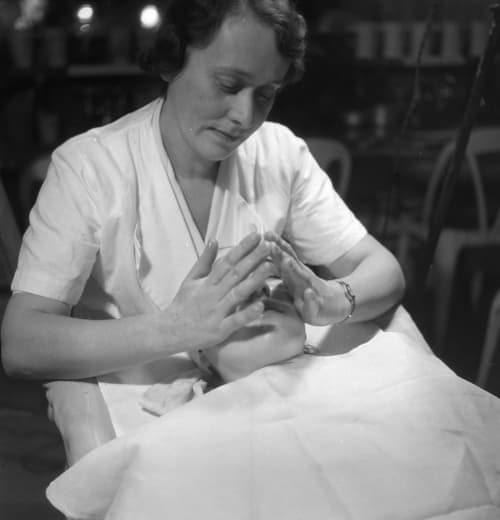
Above: 1937 Face massage (Wien Museum).
Body massages included the head, neck, arms, hands, back, breasts, legs and feet. Students in the beauty school were taught the Helene Pessl method of facial massage as well as an ‘American System’. There were also specialist facial massages for such things as wrinkles, where massage was used to ‘help increase the elasticity of the facial muscles’, and acne, where its purpose was ‘to stimulate the secretion of the sebum glands to remove excess secretions’.
Manual massages could be supplemented with the use of a Sanax machine, an electrical vibrator made by Elektrizitäts-Gesellschaft “Sanitas” of Berlin.

Above: 1925 Treatment bay at the Dianabad salon. There is a French Pulveriser and a German Sanax hand massager on the bench to the left of the assortment of cosmetics.
Individuals who did not have electricity, or wanted to spare themselves the expense, could buy a Viennese Nockit Hydro Massager which was powered by the water pressure from a household tap.
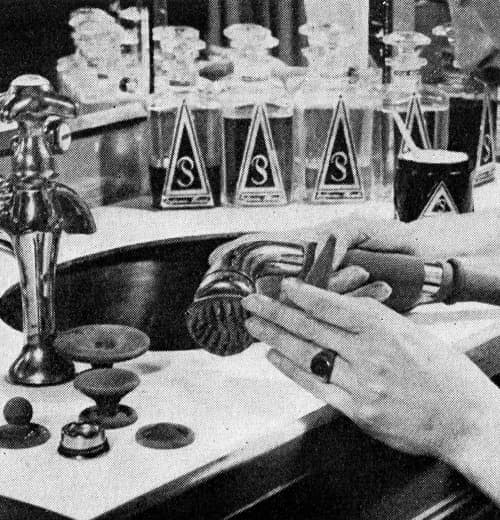
Above: Nockit Hydro Massager with various attachments. Helene Pessl preparations can be seen in the background.
High frequency
For high-frequency treatments, Helene Pessl’s machine of choice was the Radiostat. Like the Sanax massager it was made by Sanitas of Berlin.

Above: 1933 Products available from Sanitas, Berlin including Sanax massagers and Radiostat high-frequency machines. High-frequency devices were proscribed in Austria for lay treatments so their use in the beauty industry was restricted to salons.
The assortment of glass electrodes that came with the Radiostat were put to different uses. Eye electrodes were used to massage the eye area, bulb electrodes were moved over the skin to stimulate blood circulation, stick electrodes treated smile lines, combs were used to manage hair loss, and neck electrodes were used on double chins to help firm flaccid neck muscles. Indirect high-frequency treatments, named elsewhere as Viennese massages, were also supplied.
See also: High-Frequency Treatments
Radium
Helene Pessl supplied her clients with a wide range of face mask and packs made from mud and paraffin as well as egg white, alum protein, and almond bran.
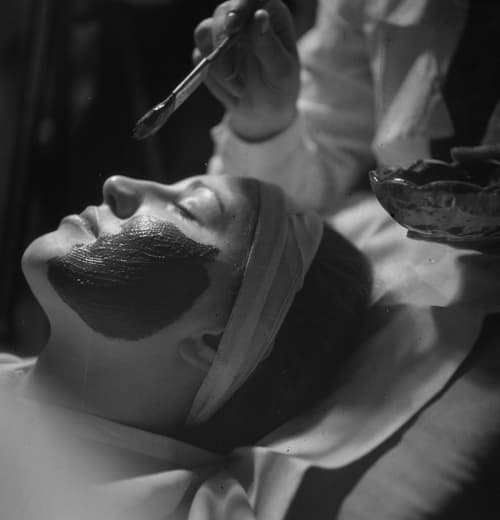
Above: 1937 Helene Pessl mud pack (Wien Museum).
The mud packs could be applied with or without radium with the Radium Mud Packs (Mud-Radio-Packungen) also available for purchase for use at home. They were applied warm and removed with cold water.
The mud packs were not the only radium beauty treatment offered by Helene Pessl. By the early 1930s, she was also selling a radium water drink, a radium skin cream, and a radium-impregnated silk mask.
See also" Radioactive Cosmetics
Floros
In 1935, Helene Pessl introduced the Floros Blaulichtlampe into her salon – a Czech invention that received a patent in 1936 – which was used to massage in a face cream. Its warmth was supposed to help the cream penetrate more easily, while the mechanical massage and blue light had soothing and healing effects respectively.
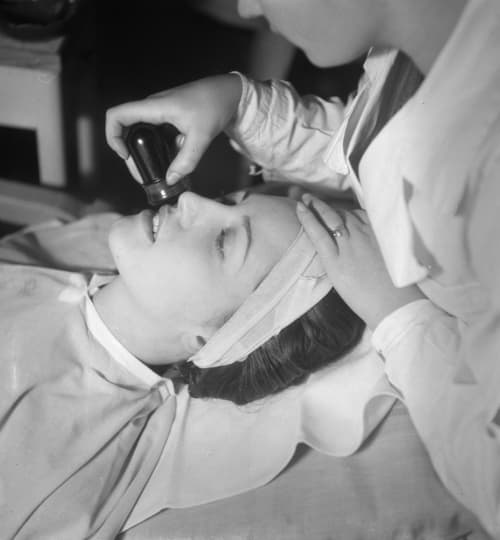
Above: 1937 Floros treatment (Wien Museum).
See also: Red Light, Blue Light and Facial Irons
Products
Most of the cosmetics sold by Helene Pessl through to the outbreak of the Second World War had been produced by the Parfumeriefabrik S. Pessl well before Helene took control of the factory in 1925.

Above: 1930 Helene Pessl cosmetics packaged in bright containers with red being the dominant colour.
Skin-care cosmetics sold by Helene Pessl included:
Schonheitscreme: A lemon-scented, cleansing cream for dry skin.
Paraderma-Hautcreme: A hand cream made with camphor.
Massagecreme: A cleansing massage cream.
Vibrol: A camphor-containing soap jelly that melts when applied to the skin and helps cleanse the pores.
Milch-Creme: A cream to be massaged in where wrinkles are likely to appear.
Hormoncreme: For very tired, withered skin.
Sommersprossencreme: A freckle cream.
Mercolized Wachs: A nose cream used as a powder base to prevent redness and shine.
Mud-Radio: A volcanic mud pack that cleanses and renews the skin and increases its elasticity.
Aqua Miranda: A toilet water containing camphor used on oily skin to dissolve excess fat and close large pores.
Aqua Supra: To remove excess oil after cleansing. Said to open the pores, make the skin fine, soft, and white and give it elasticity.
Vera Juvia: An astringent added to a steamer.
The products made allowances for different skin types. For example, women with oily skins were suggested to cleanse with Autocreme, and tone with Aqua Miranda while those with dry skins were recommended to cleanse with Schönheitscreme and then tone with Aqua Supra.

Above: 1935 Helene Pessl perfumes.
Make-up was included in the range. Unfortunately I know little about it, except to say that most areas were covered – face powders, rouge, lipsticks, mascara, eyeliner/eyebow pencils.
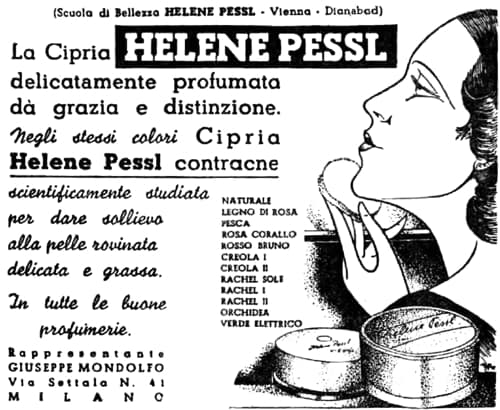
Above: 1937 Helene Pessl face powder in twelve shades (Italy).
Pessl’s Puder: Loose and compact face powders in six shades including Weif (White), Naturelle, Rachel, Rose, and Brünette later increased to twelve.
Pessl’s Lippenstifte: Lipsticks in gold or nickel cases in three shades.
Pessl’s Nagelserie: Manicure cosmetics including a nail varnish.
By the end of the 1930s Helene Pessl appears to have been selling her cosmetics outside of Austria but I do not know to what extent.
Anschluss
On March 12th, 1938, the German army crossed the border into Austria and it was annexed into the Third Reich following after a plebiscite held in April. In May, 1938, the hairdresser Robert Maurer took over Helene Pessl’s Jewish business, renaming it Paraderma in 1941. Given the dire situation for Jews both Helene and Sigmund Pessl fled the country in 1938 presumably paying the Nazi Reich Flight Tax on their way out.

Above: 1938 Helene Pessl now managed by Robert Maurer.
United States
Helene Pessl arrived in New York in September, 1938. Her oldest daughter, Yella Pessl [1906-1991], a noted harpsichordist, had moved to New York in 1931 and was employed at Columbia University, when her mother arrived.
Undaunted by the need to start again, Helene Pessl was soon making and selling cosmetics in New York and she managed to get them into a few outlets in the city, before establishing Helene Pessl, Inc. in 1942, based at 785 Fifth Avenue.
At some stage Arnold Perlman joined the firm. Like Helene Pessl he was a Jewish refugee and had arrived in the United States in 1940. A former Romanian architect, born in Bucharest, he became connected to Helene Pessl after designing a lipstick holder for another cosmetic company (Sponsor, 1954). He became the company president after Helene retired in 1947. She died in Salzburg in August, 1954.

Above: 1954 Arnold Perlman (left) [1914-2009] inspecting cosmetics.
Perlman is believed to have introduced children’s toiletries into the range starting with a bubble bath in 1944. The company had produced some baby products before this in the Baby Dear range introduced in 1942. Other products followed leading to the creation of the Little Lady (1944), Melinda (1945) and Young Lad (1945) ranges for young girls, teenage girls and young boys respectively. Perlman was unable to get the products on the cosmetic counters of department stores, so sold them in children’s clothing departments instead.
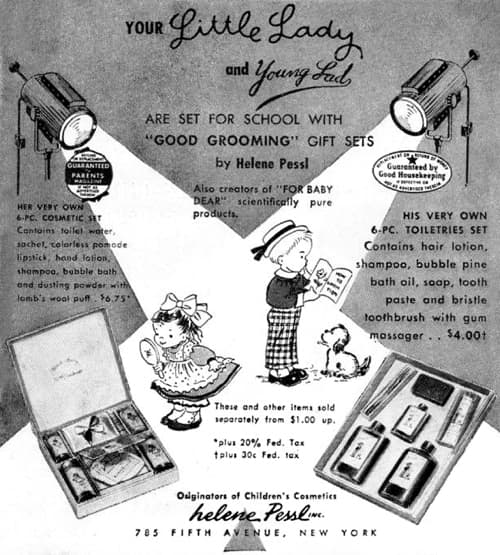
Above: 1946 Little Lady and Young Lad Toiletries.
Collectively, these were the first cosmetics specifically developed for children in the United States and the company can claim to be the ‘Originators of Children’s cosmetics’. They sold well and increasing sales saw the company opened a new US$300,000 factory in New Rochelle, Westchester County, New York in 1953. Some of the company’s success in this emerging field was due to the regular introduction of novelty ‘Toy-letries’, some designed by Arnold Perlman.
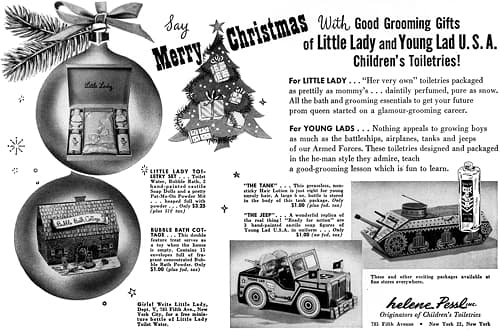
Above: 1951 Little Lady and Young Lad Toiletries.
A number of other American cosmetic companies followed Helene Pessl into this market and also began producing cosmetics for young children. Most failed but Helene Pessl continued to do good business through to its purchase by Bourjois in 1960. However, it no longer exists. Bourjois dissolved the company in 1983.
Timeline
| 1894 | Sigmund Pessl opens a hairdressing salon in Vienna. |
| 1898 | Hairdressing salon moved to Kärntnerstrasse 28. |
| 1922 | Sigmund Pessl takes over the women’s hairdressing and beauty salon in the Dianabad health resort. |
| 1923 | Perfume factory (parfumeriefabrik) established at Josefstädterstrasse 29, Vienna. |
| 1925 | Helene Pessl receives the Dianabad salon and the Pessl perfume factory in a divorce settlement. |
| 1927 | Beauty school opened. |
| 1936 | Refurbished beauty school opened in Dianabad. |
| 1938 | Anschluss. Helene Pessl loses her business. Helene Pessl moves to New York. |
| 1941 | Helene Pessl (Vienna) renamed as Paraderma. |
| 1942 | Helene Pessl, Inc. founded in New York. |
| 1944 | New Products: Little Lady range. |
| 1945 | New Products: Melinda range; and Young Lad range. |
| 1953 | Factory opened in New Rochelle. |
| 1957 | New Products: Fifteen range. |
| 1960 | Bourjois, Inc. acquires Helene Pessl, Inc. |
| 1983 | Helene Pessl, Inc. dissolved |
First Posted: 6th September 2021
Sources
Breuss, S. (2020). Das Kosmetikinstitut von Helene Pessl. Schönheit aus dem Dianabad. In Wien Museum Magazin. Retrieved August 2, 2021 from https://magazin.wienmuseum.at/das-kosmetikinstitut-von-helene-pessl
How tv sells cosmetics to little girls. (1954). Sponsor. February 22. 8(4), 36-37, 76, 78, 80.
Pessl, H. (1935). Moderne kosmetologie. Wien: Deutscher Verlag für Jugend und Volk.

Helene Pessl, née Herz [1882-1954].
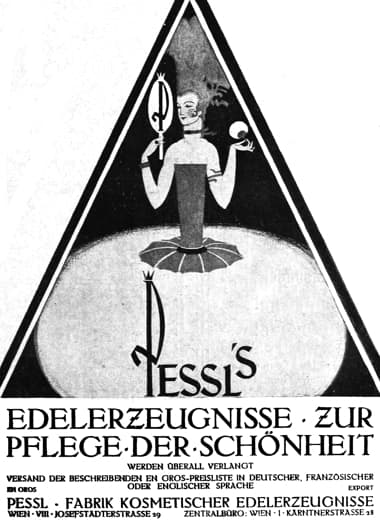
1923 Pessl cosmetics.
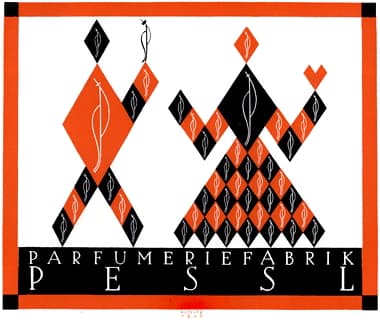
Above: 1923 Parfümeriefabrik Pessl.
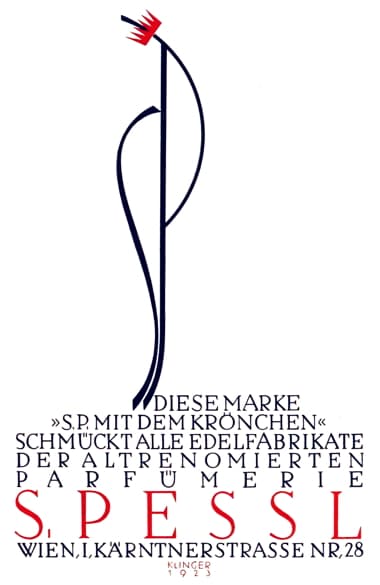
Above: 1923 Parfümerie S. Pessl.

1925 Pessl cosmetics.
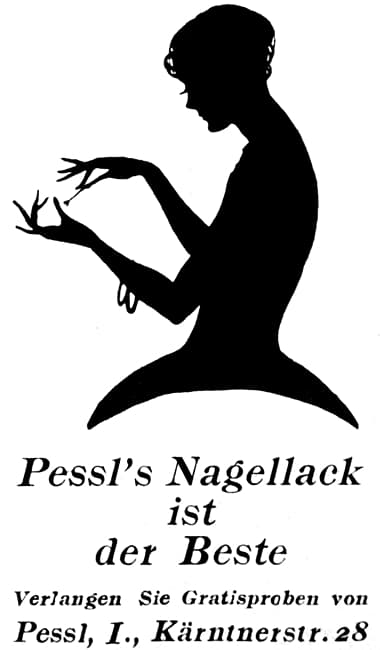
1925 Pessl Nagellack (Nail Polish).
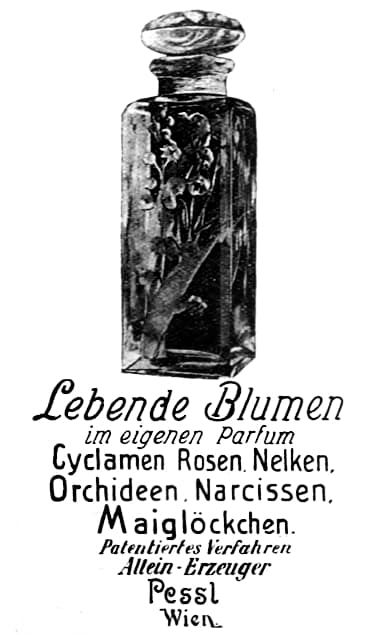
1925 Pessl Perfumes.

Sigmund Pessl [1869-1955]
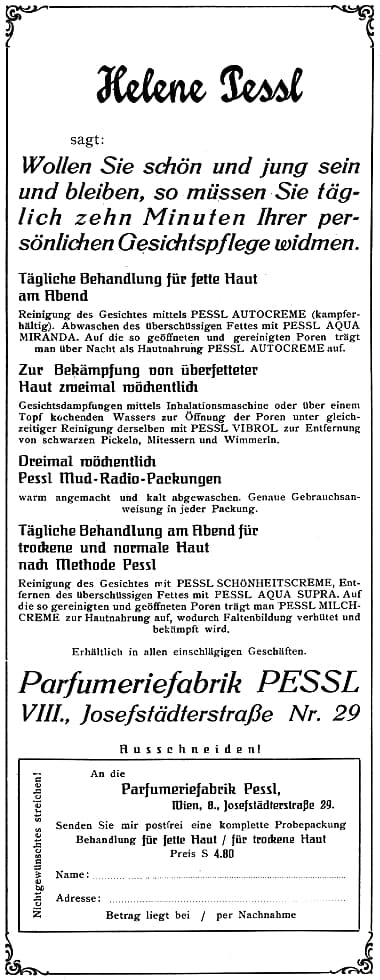
1927 Helene Pessl.
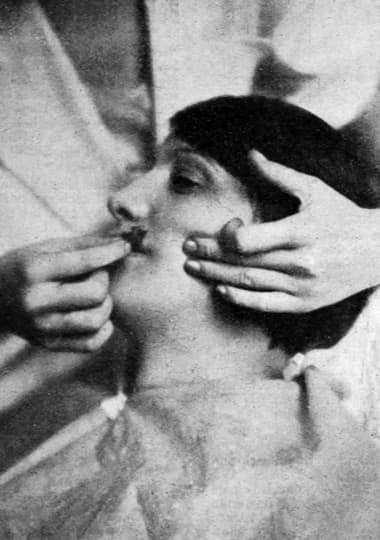
1929 Helene Pessl lip wax.
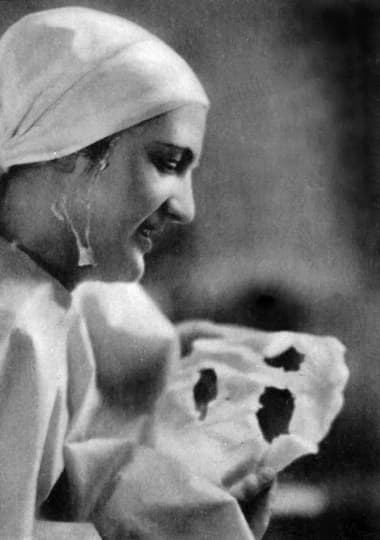
1929 Helene Pessl paraffin mask.

1929 Helene Pessl high-frequency treatment.
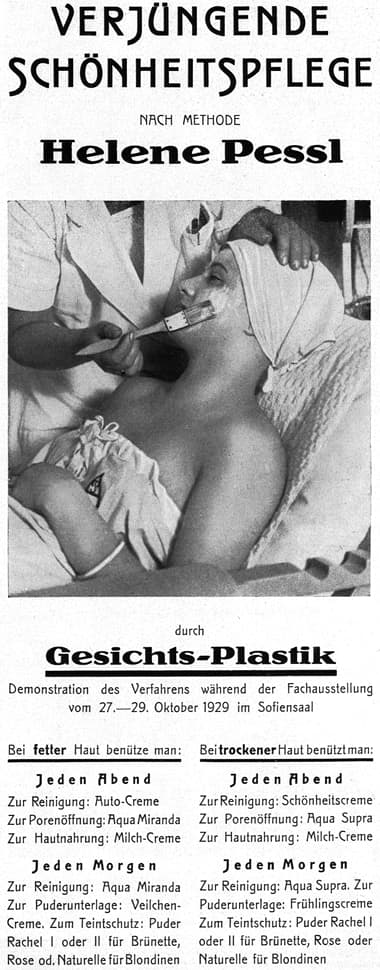
1929 Helene Pessl paraffin mask treatment.
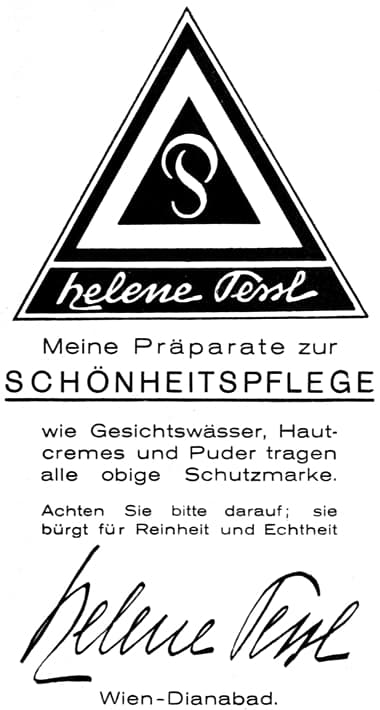
1930 Helene Pessl.
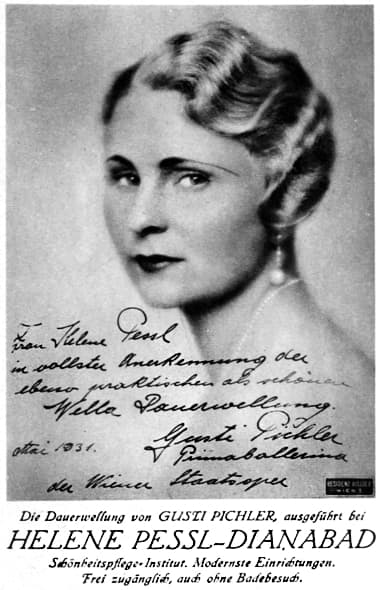
1931 Endorsement from the ballerina Auguste ‘Gusti’ Rosa Pichler [1893-1978].

1932 Helene Pessl Facial Iron. The iron was heated in warm water before being massaged over the face. The heat from the iron was supposed to help creams penetrate the skin more easily.
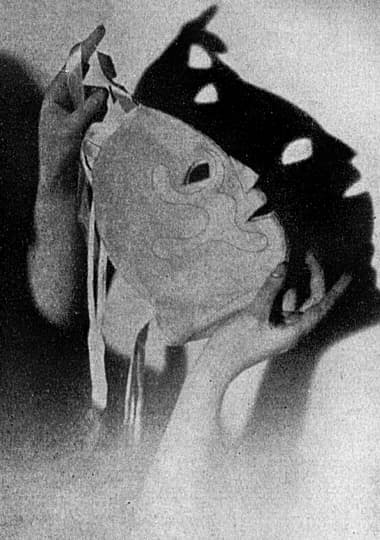
1932 Helene Pessl Radium Silk Mask.
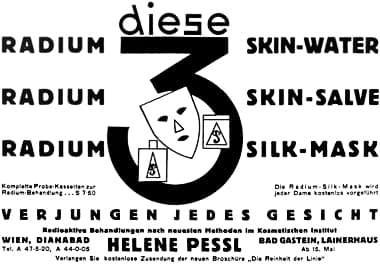
1932 Helene Pessl Radium Skin-Water, Radium Skin-Salve, and Radium Silk-Mask.

1933 Helene Pessl ‘Cocktail’ treatment.

1936 Helene Pessl Blaulicht (Blue light).
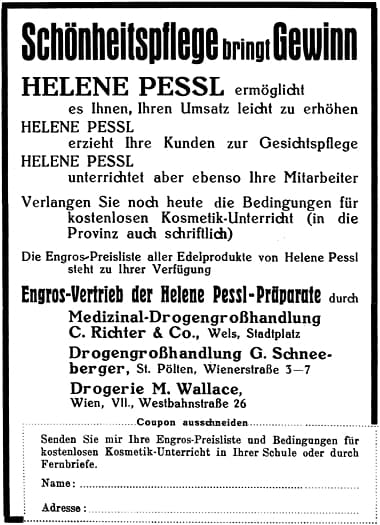
1936 Helene Pessl outlets in Vienna.
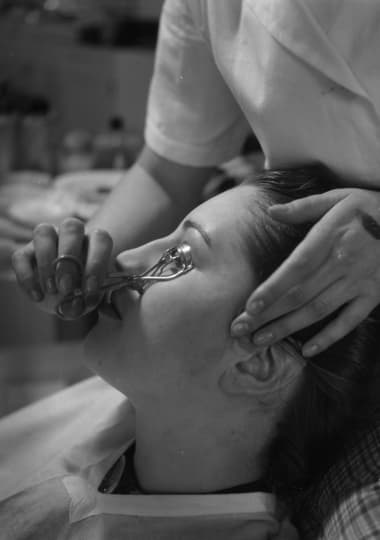
1937 Helene Pessl eyelash curling (Vienna Museum) using what looks to be an American Kurlash curler.
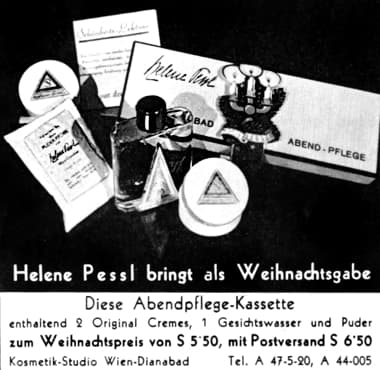
1937 Helene Pessl cosmetics.
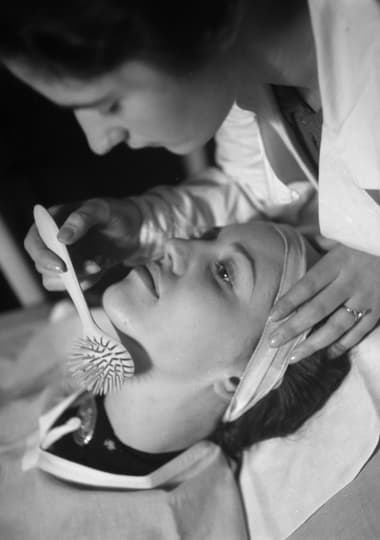
1937 Helene Pessl treatment using the back of a brush as a patter.
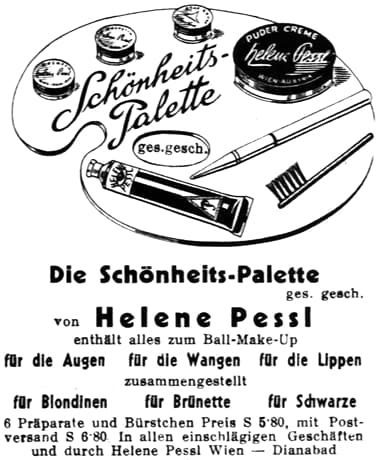
1938 Helene Pessl make-up.
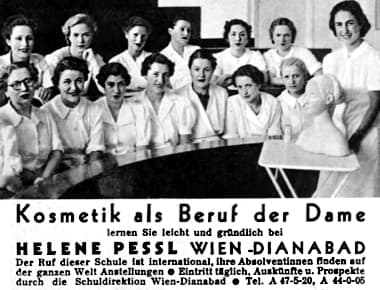
1938 Helene Pessl School in Dianabad.
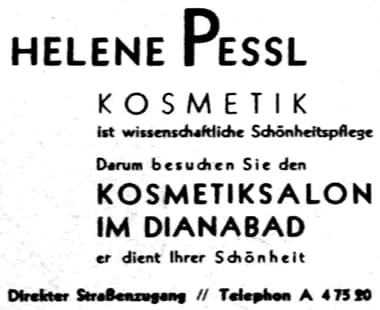
1941 One of the last advertisements for Helene Pessl in Vienna some years after she had fled the country.
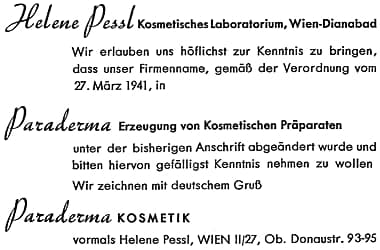
1942 Paraderma Kosmetik, formerly Helene Pessl.
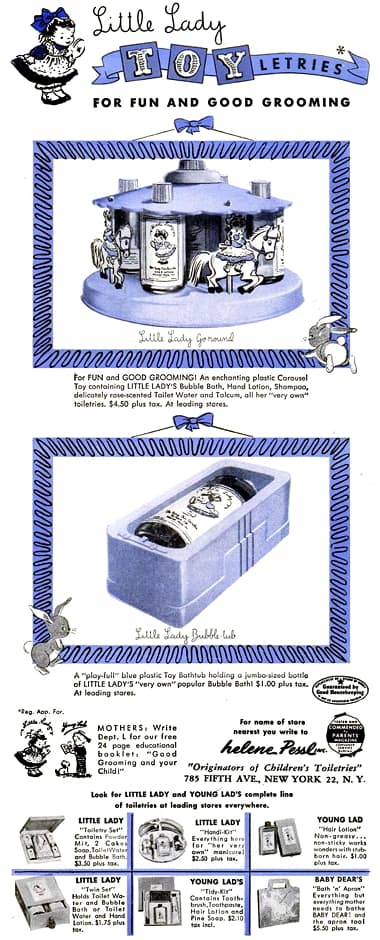
1948 Helene Pessl Little Lady (USA).

1955 Helene Pessl Little Lady (USA).
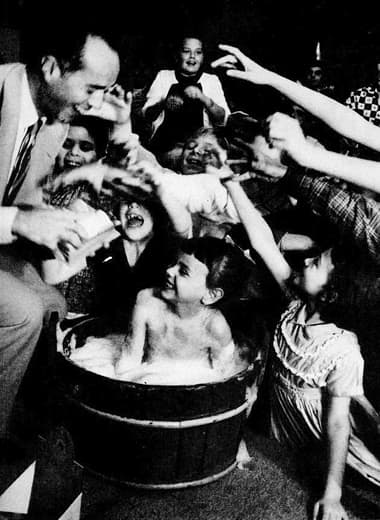
1956 Arnold Perlman handing out samples of Little Lady Bubble Bath (LIFE).

1956 Helene Pessl Little Lady Cookies ’n Milk (USA).
